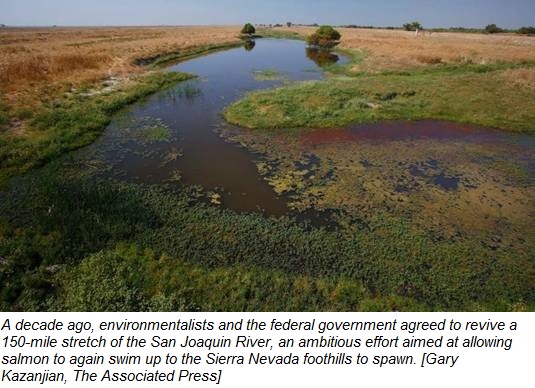By Walt Shubin, 1.6.17
Special to The Sacramento Bee
Like other farmers in the San Joaquin Valley, I paid close attention last fall when the State Water Resources Control Board released a proposal that more freshwater flow from the Sierra stay in the San Joaquin River system on its journey to the Delta.
The water board is proposing that a mere 40 percent of the flow in rivers feeding the San Joaquin – the Merced, Tuolumne and Stanislaus – make it to the Delta. Board Chair Felicia Marcus said action was long overdue to reverse loss of water quality and salmon runs.
It’s no surprise to me that Central Valley water districts, and parts of the Bay Area that get their water from the Tuolumne, raised a great hue and cry over this small step toward rational water use.
But not every farmer thinks the board went too far. In fact, this lifelong Valley farmer knows it hasn’t gone far enough to restore the balance and save the river.
Growing up in the Fresno area, I witnessed the unparalleled destruction of the San Joaquin River. I’m old enough to remember seeing San Joaquin spring-run Chinook salmon – once the largest run in the state – come up the river before dams were built and water diversion wiped out these amazing creatures.
I watched for decades as Friant Dam took every last drop of water from the San Joaquin upstream of its confluence with the Merced and left many miles of the state’s second-largest river completely dry. And I saw how farm runoff polluted with fertilizers and pesticides replaced the diverted water, representing the lion’s share of the river’s flow for long periods of the year.
These conditions led to the San Joaquin being named America’s Most Endangered River in 2014.
It’s not too late to revive the San Joaquin, her tributaries and their fisheries, but it will take more than returning 40 percent of the flow, which isn’t enough of a change from the status quo – only a third of the water now reaches the Sacramento-San Joaquin Delta. Scientists from fish and wildlife agencies, conservation groups and the water board agree that it will take between 50 and 60 percent of the river’s flow to do the job.
Residents of the San Joaquin Valley and the Bay Area, quit your bellyaching!
It’s clear that we are living beyond the limits set by Mother Nature. The same insatiable greed for water that devastated Valley rivers, water quality and salmon runs has led us to mine groundwater so intensely that some communities have trouble getting water, and the earth’s surface is rapidly subsiding. Requiring more water to remain in rivers will recharge our aquifers and make farming more sustainable in the long run.
In my younger days, I farmed 200 acres along the San Joaquin River, and I still farm 20 acres of organic raisins 4 miles from the river. I know from experience that water levels in my well and my neighbors’ wells rise when there’s more water in the river.
Everyone who uses the San Joaquin must play a part in repairing it. My fellow farmers must recognize that living in our area’s semi-arid climate imposes limits on how much we can irrigate. Bay Area residents and businesses that used money and smarts to reduce water use by more than 30 percent during the drought must recognize they can do even more by recycling water and storing it underground.
We Californians pride ourselves on being good environmental stewards. What better test of our commitment than to follow the science, learn to live within nature’s limits and make the San Joaquin a great river again?
Read more here.
